
Evaluation and Management of Fibromyalgia Alan N. Brown Medical University of South Carolina
Evaluation and Management of Fibromyalgia Alan N. Brown Medical University of South Carolina Overview of Fibromyalgia Common: 3.4% of women and 0.5% of men in the United States Accounts for 25% of all visits to rheumatologists in the United States A distinct clinical entity, as defined by the American College of Rheumatology (1990) CURRENT PARADIGM Fibromyalgia Tender Points Anterior Posterior Definition of Fibromyalgia Syndrome Widespread Pain: Above and below the waist, on the left and right side of the body, and involving the axial skeleton Pain at 11 of 18 tender point sites on digital palpation Symptoms present for at least 3 months Tender Points Problems The least objective way to measure tenderness, being highly correlated with psychological factors, especially distress Gives inappropriate impression about the nature of the problem in fibromyalgia (i.e., in the muscle) Accounts for over-representation of distressed, unfit, females Not a good measure – not normally distributed. Rarely improves in clinical trials Pain in the General Population Pain and tenderness occur as a continuum in the population % of Population 16 10% of the adult U.S. population has chronic widespread pain; 20% has chronic regional pain (Wolfe) 14 Tenderness increases with age and female gender 4 12 10 8 6 2 0 Tenderness Pain Continuum Percentile Current definition of fibromyalgia identifies top 2 4% of population Tenderness Overlap With Other Syndromes FIBROMYALGIA 2 - 4% of population; defined by widespread pain and tenderness EXPOSURE SYNDROMES e.g. Gulf War Illnesses, silicone breast implants, sick building syndrome MULTIPLE CHEMICAL SENSITIVITY - symptoms in multiple organ systems in response to multiple substances CHRONIC FATIGUE SYNDROME 1% of population; fatigue and 4/8 “minor criteria” SOMATOFORM DISORDERS 4% of population; multiple unexplained symptoms - no organic findings Symptoms and Syndromes Related to Fibromyalgia Tension/migraine headache Affective disorders Temporomandibular joint syndrome Constitutional Weight fluctuations Night sweats Weakness Sleep disturbances Irritable bowel syndrome Nondermatomal paresthesias Cognitive difficulties ENT complaints (sicca sx., vasomotor rhinits, accommodation problems) Vestibular complaints Multiple chemical sensitivity, “allergic” symptoms Esophageal dysmotility Neurally mediated hypotension, mitral valve prolapse Non-cardiac chest pain, dyspnea due to respiratory mm. dysfunction Interstitial cystitis, female urethral syndrome, vulvar vestibulitis, vulvodynia Mechanisms of Pain Acute pain Peripheral nociceptive input from thermal, chemical or mechanical nociceptors Stimulus Chronic pain Central factors typically predominate Brain Spinal cord from Robert Bennett, MD Chronic Pain – Defined by Mechanisms Peripheral (nociceptive) Central (non-nociceptive) Primarily due to inflammation or damage in periphery NSAID, opioid responsive Behavioral factors minor Examples OA Acute pain models (e.g. third molar, post-surgery) RA Mixed Cancer pain Neuropathic Primarily due to a central disturbance in pain processing Tricyclic responsive Behavioral factors more prominent Examples Fibromyalgia Irritable bowel syndrome Tension and migraine headache Interstitial cystitis / vulvodynia, non-cardiac chest pain / etc. Sensory processing in fibromyalgia A problem with the “volume control” • Patients display a normal “detection threshold”, but an increased sensitivity, to noxious levels of not only pressure, but also other stimuli, e.g. heat, noise, electrical stimulation. • The general increase in sensory sensitivity could theoretically be due to psychological or physiological factors including: • “expectancy” or “hypervigilence” • central changes in nociceptive processing (e.g., sensitization or reduced descending pain inhibition). History Diffuse, Widespread Pain Fatigue Nonrestorative sleep Associated sxs (IBS, HA, dyspareunia, etc.) Look for evidence of Obstructive Sleep Apnea Risk factors for Hepatitis C Physical Exam Often unremarkable, except for tenderness Laboratory Testing WSR TSH Hepatitis C antibodies, if risk factors present Avoid “Diagnostic Waffling” Differential Diagnosis COMMON Hepatitis C PMR Sleep Apnea/PLMS Hypothyroidism Depression LESS COMMON RA SLE Sjogren Syndrome Addison disease Cushing syndrome Hyperparathyroidism Nonpharmacologic Management “Front-Load” time with patients Education: This is a non-destructive condition Empower the patient: This is their condition to manage with your help www.med.umich.edu/painresearch/education/fmoverview.htm www.arthritis.org Management of Fibromyalgia Regular aerobic exercise (aquatherapy is good) Proper sleep hygiene; restore normal sleep patterns Use medications as an adjunct to therapy, not as the sole treatment Avoid diagnostic waffling! Set reasonable goals with the patient Cognitive Behavioral Therapy can be valuable Pharmacologic Therapy There are no drugs indicated for the treatment of fibromyalgia Tricyclic Antidepressants Cornerstone of drug therapy for fibromyalgia Amytriptylene (up to 75 mg HS) and cyclobenzeprine (up to 40 mg daily) are the best studied agents Start low-dose to maximize compliance Other Antidepressants Trazodone 50-150 mg HS SSRIs not very effective Mixed adrenergic/dopaminergic agents such as venlafaxine or nefazodone may be more efficacious Analgesics More effective in peripheral pain resulting from activation of nociceptors Limited efficacy in fibromyalgia, but widely used Analgesics Affect Different Parts of the Pain Pathway Opioids α2-Agonists Centrally acting analgesics Anti-inflammatory agents (COX-2– specific inhibitors, nonspecific NSAIDs) Pain Ascending input Descending modulation Dorsal horn Local anesthetics Opioids α2-Agonists Anti-inflammatory agents (COX-2–specific inhibitors, nonspecific NSAIDs) Dorsal root ganglion Spinothalamic tract Local anesthetics Peripheral nerve Trauma Peripheral nociceptors Local anesthetics Anti-inflammatory agents (COX-2–specific inhibitors, nonspecific NSAIDs) Adapted from Gottschalk A et al. Am Fam Physician. 2001;63:1979-1984. 3.23 3.23 Other Analgesics Opioids Tramadol Hypnotics Benzodiazepines Zolpidem Other agents that may be useful Gabapentin-titrate dose based on tolerability (may need up to 1200 mg tid-qid for efficacy in fibromyalgia) Dextromethorphan (150-200 mg/day in studies; caution when using with SSRIs) Summary : What is Fibromyalgia? A discrete disorder The end of a continuum (everyone has a little FM sometimes; some people have a lot all the time) The prototypical chronic central pain state, that can help us understand central mechanisms that play a role in pain transmission in both pure central pain syndromes (i.e. FM), as well as a subset of individuals with “mechanical” and “inflammatory” pain Bottom Line Fibromyalgia is a real disorder Patients with fibromyalgia do suffer Behavioral therapy is vital for successful management Regular aerobic exercise is crucial Medication is an adjunct to therapy
© Copyright 2025





















